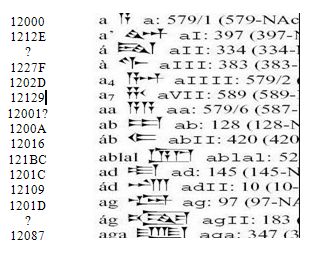- Previous message: Hans Aberg: "Re: hexatridecimal internationalisation"
- In reply to: Kenneth Whistler: "Re: Cuneiform Signs"
- Messages sorted by: [ date ] [ thread ] [ subject ] [ author ] [ attachment ]
- Mail actions: [ respond to this message ] [ mail a new topic ]
Ken Whistler writes,
>>Please see the explanation of the Sumero-Akkadian Cuneiform encoding in
>>Section 14.10 of the Unicode Standard, 5.0:
http://www.unicode.org/versions/Unicode5.0.0/ch14.pdf In particular, the
encoded repertoire "is comprehensive from the Ur III period onward." In
other words, it represents Ur III Neo-Sumerian, as well as Old, Middle, and
Neo-Assyrian, and so on. As such, it cannot simply reflect Neo-Assyrian
directly.
<<
Of course with Unicode 5 on the shelf by me I have had a look at these
pages. The problem is that the emphasis has certainly been on glyphs from
the earlier Ur III phase, so much so that the correspondance with the
Neo-Assyrian signs is difficult, and sometimes impossible, to perceive. In
fact what does "comprehensive" really mean, when the Neo-Assyrian glyphs
are just not represented ?
Another indication of the (over-) emphasis on the earlier period, and the
neglect of the later, is shown in the chart in Table 14-2, where cuneiform
usage in Babylonia would appear to cease in 539 B.C., whereas in fact it
continued through the Persian, Seleucid, and even Roman, periods - there is
a cuneiform tablet from A.D. 75 ! The Table 14-2 surely represents not
cuneiform *usage* but only the pre-Persian political divisions.
>>
What would be most helpful for Assyriologists, it seems to me, would be if
someone familiar both with the Unicode encoding of Sumero-Akkadian cuneiform
characters and with the standard Neo-Assyrian sign lists in particular,
would post up the representation of Neo-Assyrian in terms of the Unicode
characters
<<
Of course that is what I began to do in the hope of using a Unicode font to
write out texts transcribed by Pinches, Strassmaier and others. However it
would take a while to go through the whole Unicode block in order to find
the correct links with the signs in Labat. For each such connection one has
to search through the Ur III forms given by Labat in order to get the right
glyph. I attach here a few lines of such a list. I have written the U+ code
next to the lines from Píska's list (akkixref.pdf), which is based directly
on Labat. -But surely such a correspondance should already have been
considered as mandatory upon those who drew up this encoding.
Raymond

- Next message: JFC Morfin: "Re: what does "internationalized" mean?"
- Previous message: Hans Aberg: "Re: hexatridecimal internationalisation"
- In reply to: Kenneth Whistler: "Re: Cuneiform Signs"
- Messages sorted by: [ date ] [ thread ] [ subject ] [ author ] [ attachment ]
- Mail actions: [ respond to this message ] [ mail a new topic ]
This archive was generated by hypermail 2.1.5 : Thu Jun 21 2007 - 03:38:03 CDT